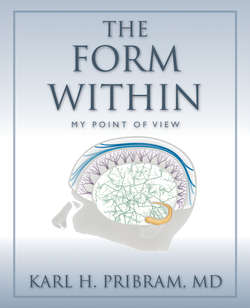Читать книгу The Form Within - Karl H Pribram - Страница 64
На сайте Литреса книга снята с продажи.
From Retina to Brain
ОглавлениеLicklider, in his 1951 Handbook of Experimental Psychology article, suggests that:
If we could find a convenient way of showing not merely the amplitudes of the envelopes but the actual oscillations of the array of resonators, we would have a notation of even greater generality and flexibility, one that would reduce under certain idealized assumptions to the spectrum and under others to the wave form. The analogy to the position-momentum and energy-time problems that led Heisenberg in 1927 to state his uncertainty principle . . . has led Gabor (1946) to suggest that we may find the solution [to the problem of sensory processing] in quantum mechanics.
30. Cross section of the eye showing biconcave lens
31. Biconvex lens processing wave fronts
32. Airy Disc
Note that Licklider is focusing on the oscillations of resonators (the hair cells of the inner ear) and that he clearly distinguishes spectrum from space-time wave forms as is performed by the Fourier procedure. The analogy to quantum processes is prescient.
Licklider stated that the problems regarding hearing that he had discussed might find a resolution in Gabor’s treatment of communication. That resolution is given, by the Gabor elementary function, a “windowed,” constrained, Fourier transformation. For me, the Gabor function provided the missing description to understanding the transformation that is taking place not only in the auditory but also in the visual process between the retina and the brain’s cortex.
As has often been noted, revolutions in science require many more steps than are apparent when we are only aware of the final result: We move forward, only to drop back a few paces when we forget what we have discovered. This is true for individuals as well as for the community. I have on several occasions found that I have backed into old ways of thinking that I thought I had abandoned. My rediscovery of Gabor’s elementary function, which he himself had momentarily forgotten while we were in Paris, proved to be a great leap forward in how to think about sensory processing in the brain.
The example Gabor used was taken from music: the pitch of a single tone is dependent on the frequency of vibration; the duration of the tone is measured in time. The complete mathematical description of the tone must therefore include both its frequency (and in case of harmonics, the spectrum) and its duration. Gabor’s transformation provides simultaneous space-time and frequency coordinates, whereas, when using Fourier’s transformation, we must choose between space-time or a spectrum of frequencies. The non-spectral coordinate in the Gabor function includes both space and time because a message not only takes time to be transmitted but also occupies space on the cable.
In brain science, we also use spatial as well as temporal frequency (spectral) coordinates to describe our findings. In addition, when we deal with a spectrum of frequencies per se, we often substitute the term “spectral density” to avoid a common confusion that Gabor pointed out in his paper: non-mathematicians, even physicists, often think of frequencies as occurring only in time, but when mathematicians deal with vibrations as in the Fourier transform, frequencies are described as composing spectra and devoid of space and time.
In Gabor’s pioneering 1946 paper, he found the mathematics for his “windowed” Fourier transform in Werner Heisenberg’s 1925 descriptions of quantum processes in subatomic physics. In reference to Heisenberg’s use of mathematics to describe subatomic quantum processes, Gabor called his elementary unit a “quantum of information.” When, therefore, in the early 1970s, my laboratory as well as brain scientists the world over began to find that the receptive fields of cortical cells in the visual and tactile systems could be described as two-dimensional Gabor functions, we celebrated the insight that windowed Fourier transforms describe not only the auditory but other sensory processes as well.
33. OHM and Helmholtz’s Piano Model of Sensory Processing
The form of communication, a mental process, and the form of the construction of cortical receptive fields, a material physical process, could now be described by the same formalism. At this level of inquiry, an identity is established between the operations of mind and of brain. This identity has led ordinary people, as well as scientists and philosophers, to talk as if their brain “thinks,” “chooses,” “hurts,” or is “disorganized.” In the language of philosophy, this is termed misplaced concreteness: It is we the people who do the thinking, choosing, hurting, and who become discombobulated. So it is important to specify the level, the scale of inquiry, at which there is an identity of form (at the receptive field level in the brain) and where mind (communication) and body (brain) are different. More on this in Chapters 22–24.
